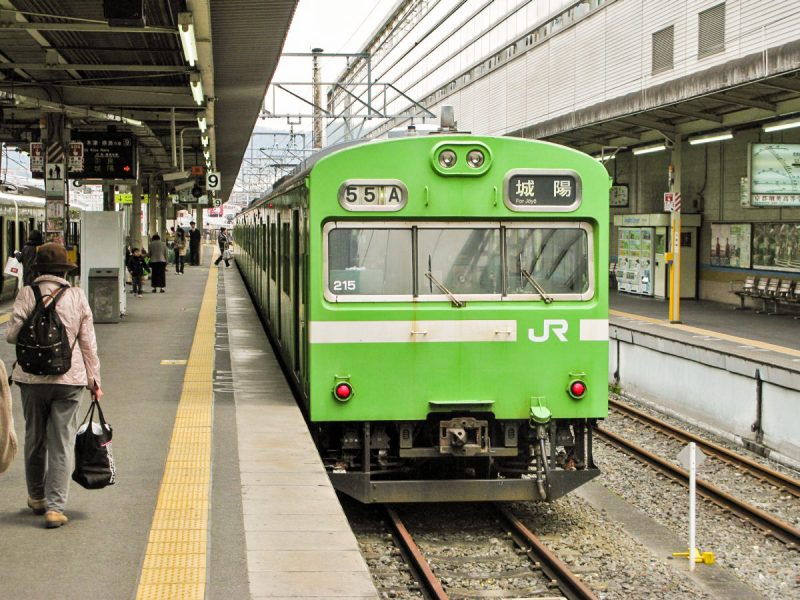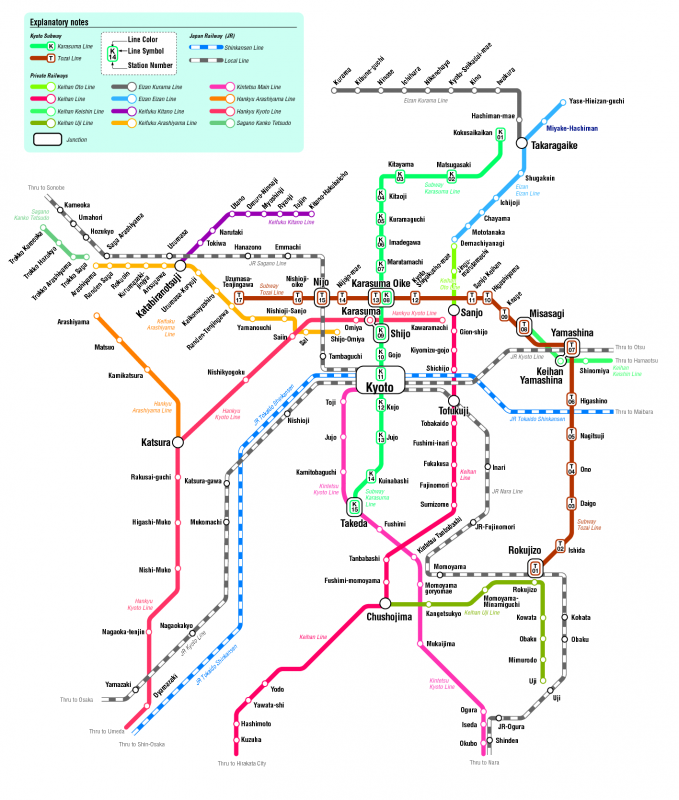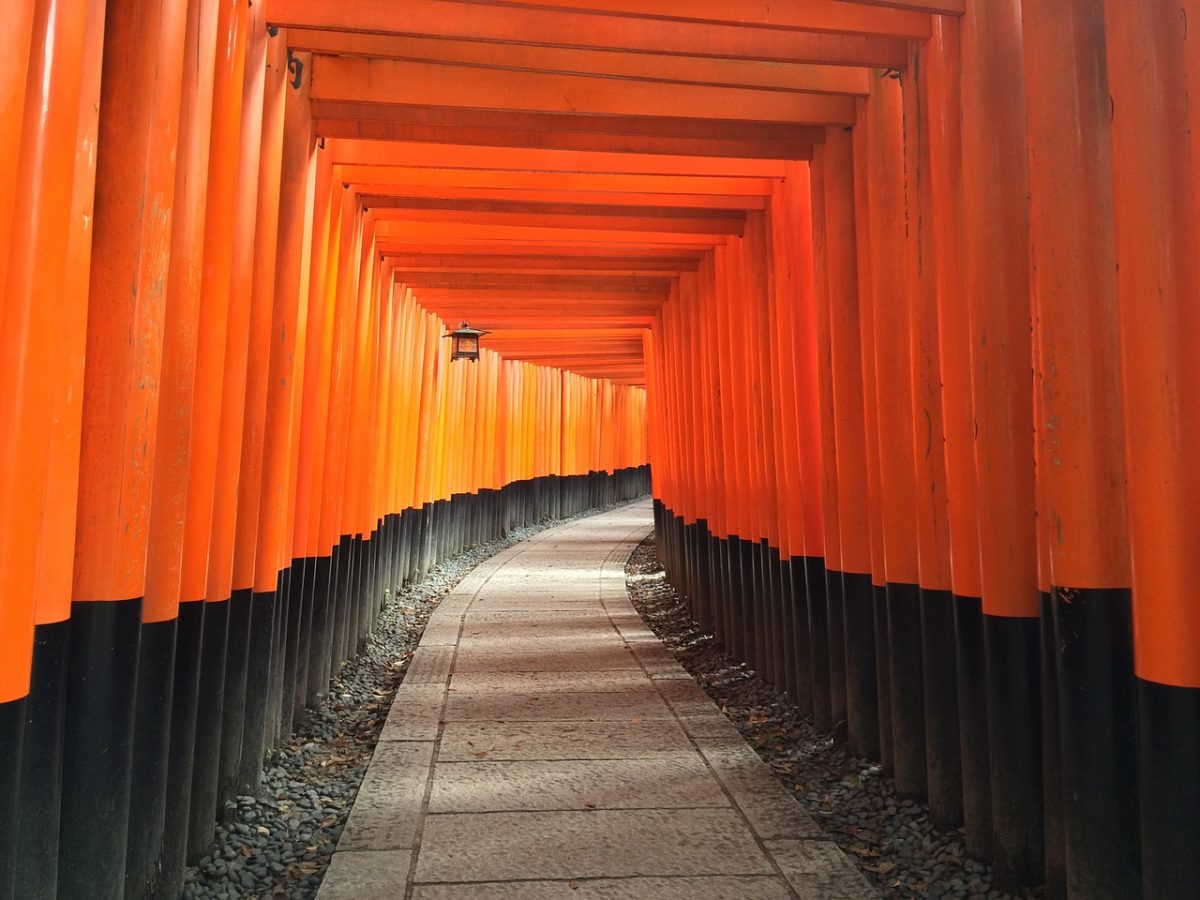So, you’ve arrived in Kyoto — Japan’s cultural center. The next question is: how do you get around this remarkable city?
Taking advantage of Kyoto’s excellent public transport system is a good way to go about it! Local trains, a convenient subway, and a bus network can zip you around the city in no time.
Take advantage of your Japan Rail Pass to cover any train journeys included in its terms.
Kyoto Station is the central city’s transportation hub for Japan Railways and other private services. From here, you can access the Shinkansen bullet train to Osaka, Tokyo, and many other destinations.
Local JR lines in Kyoto include the Sagano Line and the Nara Line.
Although the JR Pass is just for trains, you can use an IC card, such as the ICOCA or PITAPA, to access the subway and buses during your stay.
Table of Contents
JR Nara line
The Nara Line travels south to:
- Tofukuji Station, close to the Tofukuji Buddhist temple, famous for its gardens.
- Inari Station, near Fushimi Inari, an important Shinto temple famous for its thousands of torii gates.
- Uji Station, a small city popular for its tea shops and World Heritage temples (Byodoin and Ujigami-Jinja), also famous for its matcha (green tea).
- JR Nara Station, in downtown Nara. Make sure to take the Miyakoji Rapid Train, since it doesn’t stop at all stations and is the fastest connection (from Kyoto Station to Nara in 45 minutes).
JR Sagano line
The Sagano Line is actually a nickname for the urban section of the JR San’in Main line. This line travels to popular tourist destinations such as:
- Nijo Station (close to Nijo castle)
- Emmachi Station (bus connection to Kinkaku-ji, the Golden Pavillion)
- Uzumasa Station (Toei Kyoto Studio Park)
- Saga-Arashiyama Station, near Arashiyama bamboo grove, Arashiyama Monkey Park and the Sagano Scenic Railway station).
Note: Please check our full “Things to do in Kyoto” guide for further tourist information.

Kyoto Metro system
The Kyoto subway system operates two lines, the Karasuma Line (north to south) and the Tozai Line (east to west). Both lines are available from Karasuma Oike Station. The best use of the subway system is to reach attractions in the city center.
The metro ticket prices range from ¥210 to ¥350 for adults and ¥110 to ¥180 for children.
The trains of the Kyoto metro system are not covered under your Japan Rail Pass.
The most convenient way to cover your metro journeys is to get a Japanese IC Card, which you can recharge as needed.
Other rail lines
Kyoto is also home to several private railway lines, including the Keifuku, Kintetsu, and Eizan Lines.
The Hankyu Line can be accessed from the city center and using this line you can reach Osaka from Kyoto. This line also serves Arashiyama.
The Keihan Line can be used to reach Fushimi Inari from the east side of Kyoto. The JR Pass, however, is not valid on private rail lines.
Also of interest is the scenic Sagano Scenic Railway train, which departs from Saga-Arashiyama Station. While not covered by the JR Pass, the autumn leaves or spring cherry blossoms as seen from this train are well worth the trip.
Unfortunately, the JR Pass is not valid for these private rail lines, so you’ll have to buy separate tickets.
Finally, the Haruka Airport Express connects Kyoto Station with the Kansai International Airport, near Osaka. You can take this train for free with your Japan Rail Pass.
Kyoto train and subway map

For further information, including a map of the whole Kansai region, please check our maps page.
Buses in Kyoto
Kyoto’s extensive bus network operates daily from 6 AM to 10:30 PM.
You get on the local buses through the back door, where you pay the fare. You then get off at the front.
Flat rate bus fares are ¥230 for adults and ¥120 for children. Alternatively, you can purchase a City Bus All-Day Pass for ¥500, or ¥250 for children. You can also use an IC Card.
When using JR buses, you can ride free of charge when you scan your JR Pass upon entering.
JR buses
The Japan Rail Pass is valid for West JR Bus company, which operates the Takao Keihoku Line. This line runs between Kyoto station and Shuzan. You will be able to go to Ninnaji Temple and Ryoanji Temple.
The bus runs in five different type of routes, so please check the bus stop maps or Google Maps before hopping on:
- Via Ritsumeikan University
- Via Ichijou street
- Via Karasuma
- Counterclockwise
- Clockwise rotation
The line between Kyoto Station and Shuzan via Shijo-Omiya Station is known as one of the more scenic routes, passing a number of temples.
City buses
To get to some of the landmarks and attractions you want to visit, you might have to catch a city bus. The two main companies are Kyoto City Bus (central city area) and Kyoto Bus (for the surrounding areas).
If you take the Kyoto City Bus 205 from Kyoto Station and get off at the Kinkakuji-mae bus stop, you can walk to the Kinkaku-ji, the Ryoan-ji, and the Myoshin-ji Temples.
To visit the Ginkaku-ji Temple and the Honenin Temple in north-east Kyoto, you can catch the Kyoto City Bus 5 or 17 from Kyoto Station and get off at the Ginkaku-ji-michi bus stop. If you walk another 20 minutes from here you can also see the Eikando Temple and the Nanzenji Temple.
Raku buses
Alternatively, there are a number of tourist buses, known as Raku buses, which connect a number of Kyoto’s points of interest.
Raku Bus 100 leaves Kyoto Station every 10 minutes between 7:40 and 17:00, stopping at the National Museum & Sanjusangendo Temple, Kiyomizu-dera Temple, Gion, Heian-jingu Shrine, and Ginkaku-ji Temple.
Raku Bus 101 leaves Kyoto Station every 15 minutes between 8:00 and 16.30, stopping at Kyoto Station, Nijo-jo Castle, Kitano Tenmangu Shrine, Kinkaku-ji Temple, Daitokuji Temple and the Kitaoji Bus Terminal.
Raku Bus 102 leaves the Ginkaku-ji-michi bus stop every 30 minutes between 8:04 and 16:34, stopping at Ginkaku-ji Temple, Kyoto Imperial Palace, Kitano Tenmangu Shrine, Kinkaku-ji Temple, Daitokuji Temple, and Kitaoji Bus Terminal.
Taxis in Kyoto
In downtown Kyoto, you will also find taxis waiting at nearly every street corner, at all times of day and night.
When hailing a taxi, pay attention to the light located next to the driver. A red light means the taxi is available, while a green or blue light indicates that the taxi is already in the service of another customer.
In Japan, taxi doors open and close automatically, so don’t worry about shutting the door when you exit.
When selecting a taxi, keep in mind that the MK or Yasaka companies – marked with a clover icon – are generally cheaper. Whichever service you use, you may expect to pay about ¥640 for the first two kilometers.
Tip: When telling your driver where you would like to go, naming an intersection, restaurant, or attraction is often more efficient than giving him a specific address.
Walking and biking
Kyoto’s street grid system makes it simple for both pedestrians and cyclists to find their way around.
In Kyoto, main streets run either north to south or east to west. North-south streets are given names, while east-west streets are given numbers. Keeping this in mind can aid you in orienting yourself and understanding the direction in which you are traveling. The flat terrain makes this city ideal for touring on foot.
As you will likely not have your own bicycle with you, many bike rental stores are available in Kyoto, especially in the Arashiyama area. You may rent a bicycle for a few hours or up to two weeks.
Prices range from ¥500 per day to ¥2000 per week. Be advised that in the city center and near train stations, bikes must be parked in designated areas. Bike parking usually costs ¥150 for up to eight hours. Bikes parked illegally will be towed.
